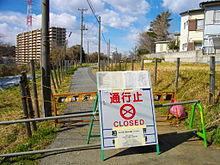Japan: Fukushima is still a cause for concern

Radiation hotspot Kashiwa - Wiki
March 11, 2011 was a black day in recent Japanese history. An earthquake registering 9.0 on the Richter scale followed by a tsunami, which in places reached the height of a 12 storey building, hit the Fukushima area of northeast Japan. The tsunami destroyed the back-up generators at the Fukushima Daiichi nuclear plant, knocking out the cooling system for the reactors. This resulted in a build-up of pressure which caused hydrogen explosions and the eventual core meltdowns in three out of the six nuclear reactors at the plant. Radioactive isotopes of xenon, iodine, cobalt, cesium and others were immediately released into the air.
Thousands of tons of water contaminated with these dangerous substances leaked into surrounding groundwater and the Pacific Ocean. It is estimated that almost 20,000 people lost their lives and a further 350,000 residents had to be relocated. The impact of the contamination on human health and the environment is still being felt, three-and-a half years after the disaster.
Human Health Effects
Thus far there are no conclusive studies on definitive impacts of radioactive isotopes on people near the site of the disaster. Radioactive iodine-131 is of particular concern in terms of human health as it can accumulate in the thyroid gland and lead to thyroid cancer as happened in the aftermath of the nuclear explosion at Chernobyl in 1986.
It is important to remember that there is no threshold for radiation that people can tolerate without side effects. Rather, any exposure to radiation increases cancer risk – greater contact with radiation leads to more people developing cancer.
According to the latest research, there is an extremely wide variation in the number of illnesses and deaths estimated to result from Fukushima: “between 15 and 1,100 fatalities and between 24 and 1,800 additional cancers” depending on the models used. The reason for the wide parameters in the projection is that both the atmosphere and the oceans can dilute the intensity of the radiation and weaken its effect.
The story is quite different when it comes to assessing the health risks for those who worked at the plant and for children who were living close to the plant when the accident occurred. According to the United Nations Scientific Committee on the Effects of Atomic Radiation the cancer risk for exposed children is two to three times higher than for the rest of the population in the area. Tests carried out in the area in March 2014, found that 33 Fukushima children were already confirmed cases of thyroid cancer, with 42 more cases suspected. This is quite high given that there was only three years exposure to radiation. It is expected that cancer rates will increase as radiation from the stricken plant continues to contaminate the air and water of Fukushima and its surroundings.
Contaminating the food chain
Although Fukushima is not expected to directly affect human health outside of Japan, the radiation seeping into the Pacific may contaminate the global seafood supply. Radioactive iodine is taken up in the thyroid tissue of fish and marine mammals, and cesium into the muscles. The half-life for Cesium is 30 years, so it will continue to remain active in our oceans for decades to come. This radioactive material continues to build up along the food chain. Organisms higher up the food chain “biomagnify” the radioactivity so that organisms such as fish which are at the top end of the scale become more dangerous to ingest. Furthermore the radioactive materials in food come into contact with people internally, as opposed to externally. For this reason safe limits for consumption must be closely monitored.
Fishing in the Pacific Ocean around Fukushima has been closed since the disaster because the seafood contains radioactive levels unsafe for human consumption. This has had a major impact on the livelihood of Japanese fishermen who previously relied on fish catches on the eastern coast of Japan to feed their families as well as support themselves financially. The tourism industry has also been affected. Tourism in Japan dropped after the disaster from 8.6 million in 2010 to just 6.2 million in 2011. Though national levels of tourism have rebounded, tourism in the areas surrounding Fukushima has collapsed. The decline in both the fishing and tourism industries has hurt the local economy and will continue to do so until the site is free of nuclear material. This will take decades and the cost will be enormous. Here is the real dark side of nuclear power.


















